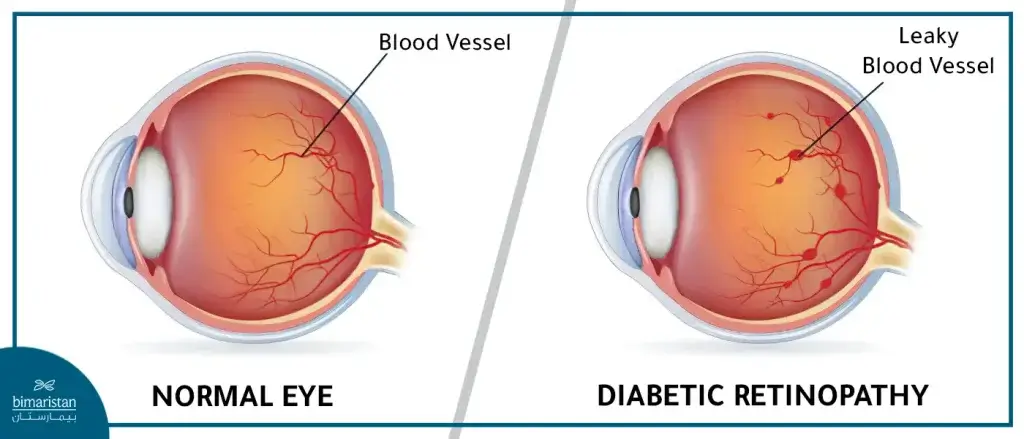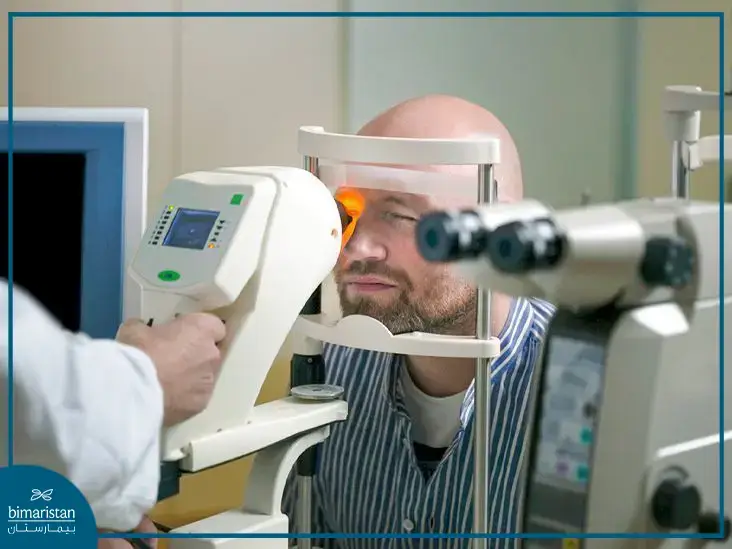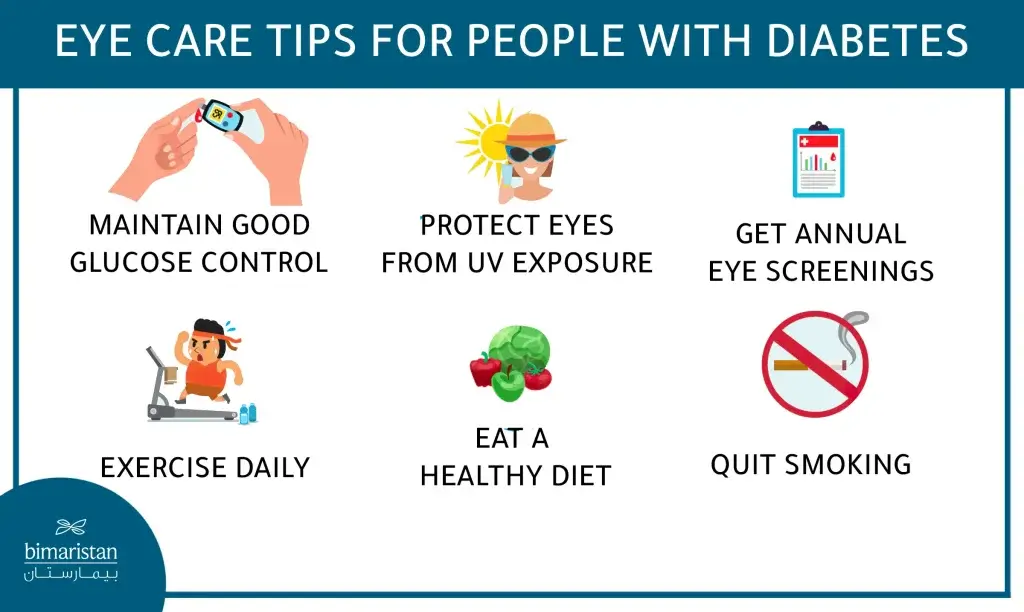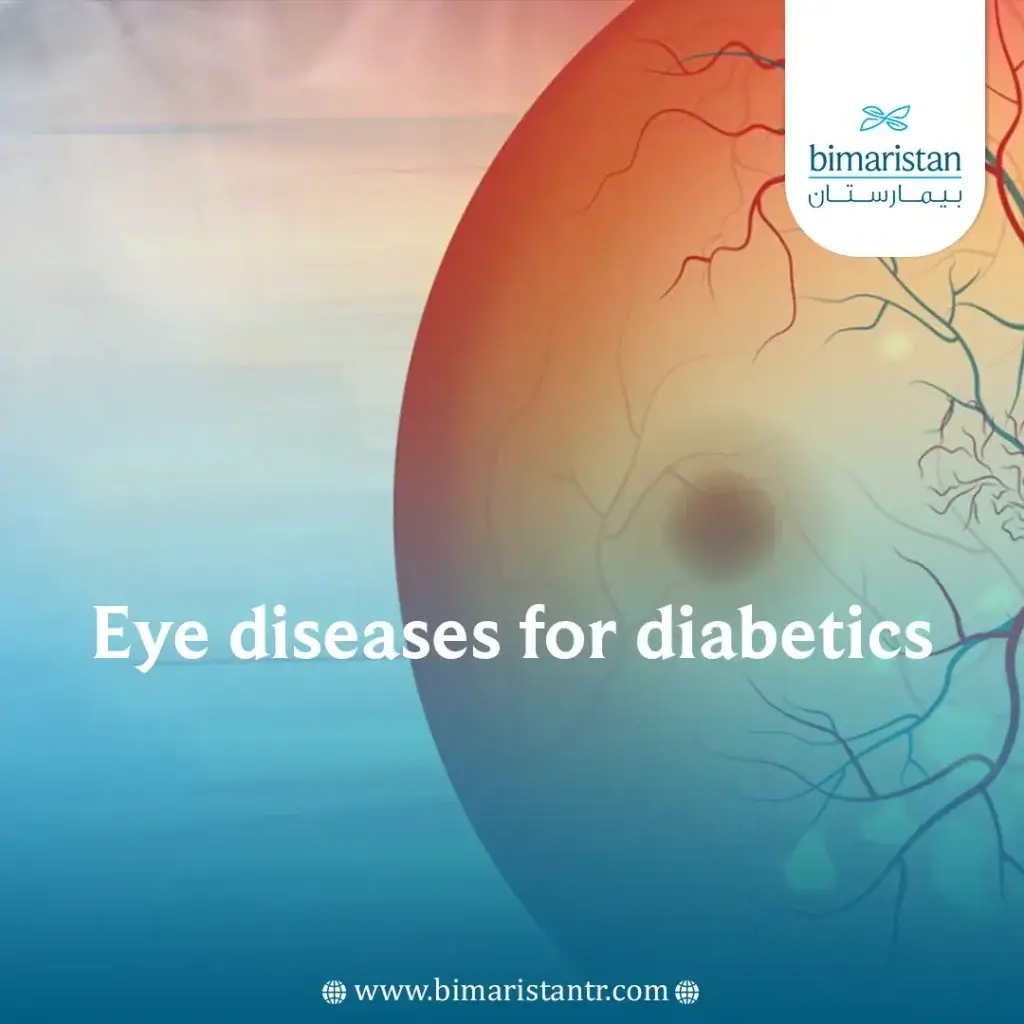Diabetes and eye diseases for diabetics represent an unprecedented pandemic, as the latest global epidemiological estimates from the International Diabetes Federation indicate that 10.5%, or more than 1 in every 10 adults worldwide, are currently living with diabetes, accounting for more than half a billion people. Additionally, the incidence of this disease has become widespread globally. Eye diseases for diabetics are common and major complications of this disease, occurring in 30% to 40% of diabetic patients. Eye diseases for diabetics are global issues that require extensive attention in how to manage and treat such cases, as they are a major cause of blindness and vision loss in adults.
Does low blood sugar affect the eye?
Low blood sugar can exacerbate eye diseases for diabetics, as it has been shown that people who experience periods of low blood sugar levels, especially those new to managing this disease, can experience an increase in certain proteins in the retina, leading to excessive blood vessel growth and worsening eye diseases for diabetics.
Does high blood sugar affect the eye?
Diabetic patients often suffer from several serious eye diseases, the most common and significant of which is diabetic retinopathy, which can lead to a high percentage of blindness if not properly managed and treated. The risk of developing eye diseases for diabetics increases significantly if blood sugar levels are very high or if the condition is accompanied by notably high blood pressure.
Diabetic Eye Conditions
Diabetes can cause numerous eye problems and can lead to blindness, as people with diabetes are more likely to develop eye diseases compared to others. Many diabetic patients suffer from blurred vision, dry eyes, poor night vision, dark spots in vision, and sometimes blindness. Additionally, it can cause various eye diseases, with the most prominent eye diseases for diabetics being:
- Diabetic retinopathy
- Corneal abnormalities
- Glaucoma
- Rubeosis iridis
- Cataracts
Vision Loss with Diabetes
Diabetes can cause significant damage to the eyes over time, leading to what is known as eye diseases for diabetics and, consequently, vision loss if the disease is not properly treated.
In diabetes, the small blood vessels that supply the retina can become damaged, causing vessel damage and fluid leakage into retinal tissues, leading to retinal thickening and blurred vision. Alternatively, the damaged blood vessels may close due to high blood sugar levels, leading to the formation of abnormal and weak blood vessels to supply the retina, eventually forming scar tissue that can grow over time and cause vision loss.
Diabetic Retinopathy
Diabetic retinopathy is one of the most common eye diseases for diabetics. This disease occurs due to damage to the blood vessels in the retina caused by high blood sugar levels. These vessels may swell, leak fluids, or even close, preventing normal blood flow to the retina. In response, several abnormal blood vessels may grow on the retina’s surface, leading to vision loss due to all these changes.

Eye inflammation in diabetic patients
Eye inflammation occurs in response to infection, allergies, autoimmune disorders, or eye trauma. Different parts of the eye may be affected, depending on the cause of the inflammation. It is a common condition and can occur at any age. The duration and treatment of eye inflammation depend on the type and severity of the disease. Most cases of eye inflammation can be successfully treated. However, if the patient has diabetes, immediate follow-up and treatment are necessary because diabetes can significantly exacerbate the severity of inflammation. Therefore, it is crucial to promptly see a specialist if any signs or symptoms of eye inflammation appear.
Stages of Diabetic Retinopathy
The early stages of diabetic retinopathy and other eye diseases for diabetics usually do not cause any symptoms. Still, some people may notice changes in their vision, such as difficulty reading or seeing distant objects. In the advanced stages of the disease, blood vessels in the retina begin to bleed due to damage caused by high blood sugar levels, leading to more severe symptoms. The stages are as follows:
Stage 1: Mild Non-Proliferative Diabetic Retinopathy
Small pockets of swelling in the form of microaneurysms begin to form in the blood vessels. Patients at this stage usually do not experience noticeable symptoms and rarely require treatment, but it is crucial to control blood sugar levels to prevent the disease from progressing.
Stage 2: Moderate Non-Proliferative Diabetic Retinopathy
Increased damage to the blood vessels leads to blood and fluid leakage into the retina, causing blurred vision.
Stage 3: Severe Non-Proliferative Diabetic Retinopathy
If blood sugar levels remain high, larger areas of the blood vessels that nourish the retina begin to become blocked, along with ongoing bleeding and leakage, which can severely affect vision.
Stage 4: Proliferative Diabetic Retinopathy
When the blood vessels nourishing the retina are severely damaged, the body tries to compensate by growing new blood vessels. These new blood vessels are usually abnormal and weak, not forming properly, leading to more bleeding. At this stage, patients may experience vision loss or blindness.
Signs of Diabetic Retinopathy
In the initial stages of diabetic retinopathy, patients are usually asymptomatic; however, in the advanced stages of the disease, patients may experience symptoms including blurred vision, distorted vision, and gradual loss of visual acuity. The signs of diabetic retinopathy include:
- Microaneurysms: The first clinical sign of diabetic retinopathy; they occur due to the capillary walls’ swelling due to the loss of pericytes, appearing as tiny red dots in the superficial layers of the retina.
- Dot and blot hemorrhages
- Flame-shaped hemorrhages
- Retinal edema and hard exudates
- Cotton wool spots
- Intraretinal microvascular abnormalities
- Venous loops and venous beading frequently occur next to areas of non-perfusion. They reflect increased retinal ischemia, and their presence is the most significant predictor of progression to proliferative diabetic retinopathy.
- Macular edema: The leading cause of vision loss in those with eye diseases for diabetics.
Retinal Examination for Diabetic Patients
An eye fundus examination is the only way to check for many eye diseases (such as glaucoma, age-related macular degeneration, and diabetic retinopathy) before symptoms appear or vision loss occurs. The examination includes the following:
- Visual acuity test to assess the clarity of vision.
- Visual field test to check peripheral (side) vision.
- Pupil response and muscle function test to check the eye’s response to light.
- Eye pressure tests may include a puff of air or a device gently touching the eye.
- Eye dilation using eye drops makes the pupil wider, allowing the doctor to see inside the eye and examine the back of the eye, including the retina, optic nerve, and macula—where many eye diseases for diabetics appear.
The patient may experience blurry vision for a few hours after dilation.

Methods to Treat the Effect of Diabetes on the Eye
Controlling diabetes and maintaining normal blood sugar levels are primary goals in treating diabetes and eye diseases for diabetics, thus reducing the effects of diabetes on the eye.
Treatment methods for eye diseases for diabetics include:
- Control of blood sugar levels
- Aspirin therapy
- Hyaluronidase therapy
- VEGF inhibitors
- Prevention
- Laser photocoagulation
- Treatment of Proliferative Diabetic Retinopathy
Retinal Treatment for Diabetic Patients
- Pan-retinal photocoagulation (PRP): PRP is the preferred treatment for diabetic retinopathy. It involves applying laser burns to the entire retina, avoiding the central macular area and can be performed using various systems.
- Vitrectomy: Necessary in cases of prolonged vitreous hemorrhage and retinal detachment. This procedure aims to remove blood to allow for the evaluation and treatment of the posterior pole, repair retinal detachment, and remove structures where abnormal blood vessels can grow.
- Cryotherapy: Can be used when laser photocoagulation is not possible due to conditions such as cataracts or vitreous hemorrhage. It works by destroying retinal tissue to reduce its oxygen demand and creating adhesions between the choroid and retina, which may increase oxygen supply to the retina in hopes of preventing or reducing the formation of abnormal blood vessels.
Treatment of Blurred Vision for Diabetic Patients
This is achieved by keeping blood sugar within its average level in the blood through medication and an appropriate diet. Some cases of eye diseases for diabetic patients may require laser treatment or surgery in advanced stages.
Treatment of Retinal Bleeding for Diabetic Patients
Laser treatment (photocoagulation) works to repair the damage and bleeding that occurs. This is useful if the damage to the retina is not significant and is the most commonly used treatment for eye diseases for diabetic patients. More aggressive widespread photocoagulation can be used to prevent the formation of new abnormal blood vessels in the back of the retina, surgical removal of the vitreous body, or the use of medications such as anti-vascular endothelial growth factor (VEGF).
Retinal Transplant for Diabetic Patients
Although it is technically possible to transplant an artificial retina, the retina itself is not a candidate for transplantation because it contains a lot of nerve tissue and blood vessels. The retinal transplantation involves implanting a chip that provides electrical stimulation to the inner retinal nerve. After inserting the chip through the conjunctiva, a device resembling glasses is worn externally. The light stimulation is received through a camera attached to the device, which converts video signals into electrical signals that are transmitted to the chip in the eye through a magnetic field. The 3-4 mm chip directly stimulates the nerves in the inner retina, which is how the brain perceives light.
In the future, surgeons may use stem cells to replace damaged retinal cells and treat these conditions. However, this is not currently possible due to insufficient studies and technologies supporting such procedures.
Laser Treatment for Retinal Diseases for Diabetic Patients
The exact mechanism by which comprehensive retinal laser works is not clearly understood. According to one theory, destroying the oxygen-deficient retina reduces the production of factors that cause blood vessel growth, such as VEGF, which decreases the rate of new vascular formation. Another theory is that comprehensive retinal laser allows for increased oxygen diffusion from the choroid, enhancing blood circulation in the retina. Increasing oxygen in the retina also helps regulate the production of factors causing blood vessel growth and reduces abnormal new vascular formation.
Comprehensive retinal photocoagulation is the preferred treatment for eye diseases for diabetics, especially in the case of proliferative diabetic retinopathy. The presence of high-risk proliferative diabetic retinopathy is an indicator for immediate laser treatment. Laser burns are applied to the entire retina, avoiding the central area, to close leaking blood vessels causing vision problems and eye diseases for diabetic patients.
Herbal Treatment for Retinal Diseases for Diabetic Patients
Grape seeds, blueberries, and cherries contain a large amount of proanthocyanidins, which support eye and blood vessel health in general but are not considered treatments in themselves. They can help reduce the severity of the disease in some way. Hawthorn may reduce the blood vessels’ response in the eye to nervous stress, which may help reduce the severity of eye diseases for diabetic patients.
Treatment of Vision Loss Due to Diabetes
More than 92% of severe vision loss cases caused by eye diseases for diabetic patients can be treated and vision restored. This is achieved through vitrectomy, which stops bleeding from the vessels in the retina and removes any fibrous tissue that may lead to retinal detachment. This surgical procedure often restores vision and is performed under local anesthesia without a lengthy hospital stay. Other cases may be treated with laser or photocoagulation.
Treatment of Diabetic Retinopathy
In the early stages of eye diseases, the treatment option for diabetic patients, in general, may be controlling blood sugar levels within the normal range through medications, appropriate diet, and lifestyle modifications according to the patient’s specific condition.
Other cases, often advanced and undiagnosed in the early stages, require other treatments and interventions to control them, with an emphasis on controlling blood sugar first, such as:
- Laser treatment (photocoagulation)
- Vitrectomy
- Cryotherapy
- Treatment using anti-vascular endothelial growth factor (VEGF) drugs
Eliminating Diabetes Completely
There are many methods and techniques that support the control of diabetes, including:
- Proper healthy diet
- Quitting smoking
- Physical activity and exercise
- Attention to mental and psychological health
- Controlling blood sugar levels with appropriate medications
- Insulin therapy in type 2 diabetes
- Ensuring patients are knowledgeable about their disease and specific condition
- Diagnosing and treating complications of diabetes, such as eye diseases for diabetics
Preventing the Effect of Diabetes on the Eyes
Strict control of blood sugar levels is of high priority and importance in reducing the occurrence of diabetes complications and the development of eye diseases for diabetics, including diabetic retinopathy. Protecting the eyes from ultraviolet rays, regular exercise, a healthy diet, and quitting smoking are all factors that prevent eye diseases for diabetics. All individuals with diabetes should be aware of the importance of regular retinal exams, as early diagnosis and appropriate treatment can help prevent blindness in more than 90% of cases.

Early Detection of Eye Diseases Due to Diabetes
When eye diseases for diabetics are detected early, treatment can often preserve vision and even reverse vision loss. Conversely, when they are not detected early and the effects become chronic, the treatment process can be more difficult and longer. Therefore, regular eye exams for diabetic patients are highly important in treating eye diseases for diabetics.
Symptoms of Eye Diseases for Diabetic Patients
Early symptoms include:
- Cloudy vision
- Difficulty seeing at night
- Double vision
- Blurry vision in only one eye
- Redness or pain in the eye
- Loss of peripheral vision
Diabetes can lead to many serious complications and symptoms, causing numerous diseases, including eye diseases, with diabetic retinopathy being the most important. It is the main cause of blurry vision, visual impairment, and blindness. Damage to the blood vessels in the retina can cause many vision problems, but they are often asymptomatic in the early stages. This explains the high importance of regular eye exams for diabetic patients for early diagnosis and effective treatment. Maintaining normal blood sugar levels is fundamental in preventing all diabetes complications and diseases. Therefore, there is ongoing effort worldwide to improve and develop methods for treating eye diseases for diabetics due to their severity and impact on patients’ lives.
Resources:
